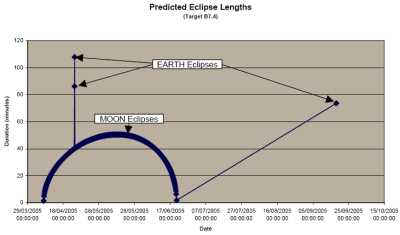No. 36 - Ongoing Lunar Commissioning
Future activities
- Instrument commissioning and start of science phase
- Fine tune procedures and tools to optimise Lunar phase
Spacecraft Status
AOCS
The AOCS subsystem has been nominal during the period 14 to 27 March 2005. The spacecraft has been following a Moon nadir-pointing attitude during the entire orbit and period except for short periods of Earth pointing where the MGA antenna was pointed to the Earth in order to download data.
Electric Propulsion
The EP has been off during the entire period and will remain so for the next few months. The table below shows a summary of EP performance to date.
| Total number of pulses | 526 |
| DOY of last pulse | 71 |
| Date of last pulse | 12 March 2005 |
| Acumulated Cathode A time (h) | 3511.59 |
| Accumulated Cathode B time (h) | 1115.86 |
| EP Hours firing (h) | 4627.456 |
| Xenon mass left (kg) | 9.933 |
| Xenon mass used (kg) | 72.567 |
Star Trackers
Both star trackers have been working within operational temperatures (below 19 °C) during the period 14 to 26 March. On 27 March, however, the star tracker #2 temperature reached 19.66 °C. Throughout the period the average temperature of ST#1 was 6.19 °C as opposed to 17.10 °C for ST#2. This was solely due to the attitude of the spacecraft and ST#2 undergoing greater exposure to solar radiation.
Power
Since the EP system is inactive there is plenty of power available for Lunar science activities. The main factor in determining the power output from the solar arrays over the coming months is the spacecraft-Sun distance.
Instrument Status
Commissioning activities have been ongoing with no reported problems.
Orbital Information
Eclipses
A new season of eclipses is due to begin on 6 April with a penumbral eclipse and a full umbral eclipse on 7 April. The duration of eclipses will increase to a peak of around 50 minutes toward the end of May. The plot below shows the distribution of eclipse durations in the coming months.
 |
|
Duration (min) of eclipses for the period 29 March to 15 October 2005 |
On 24 April four eclipses, two Earth and two lunar, will occur:
| Start Time (UTC) | End Time (UTC) | Duration (min) | Type |
|
05:27:21 |
06:07:19 |
39.96 | Lunar |
|
08:03:08 |
09:29:19 |
86.16 | Earth |
|
10:25:35 |
12:13:31 |
107.94 | Earth |
|
15:23:48 |
16:04:10 |
40.38 | Lunar |
Orbital parameters
|
SMART-1 OD229 - Close to Apolune 369 | |
| Pericentre Distance (km) | 2257.315951 |
| Apocentre Distance (km) | 4549.680236 |
| Semi Major Axis (km) | 3403.498093 |
| Eccentricity | 0.336766 |
| Inclination (°) | 90.087897 |
| Ascending Node (°) | 236.687631 |
| Argument of Pericentre (°) | 278.617404 |
| True Anomaly (°) | 180.008804 |
| Osculating Orbital Period (h) | 4.94297 |
The changes since apolune 334 are as follows:
- Semi-major axis: - 0.4 km
- Perilune height: + 2.7 km
- Apolune height: - 3.5 km
- Orbital period: - 0.0 min
